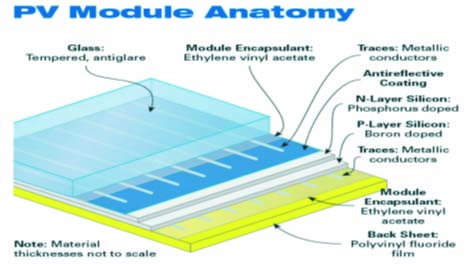The basic unit of a photovoltaic system is the photovoltaic cell. Photovoltaic (PV) cells are semiconductor material (usually Silicon) directly converting energy from sunlight to electricity by releasing electrons from their atomic bonds, producing an electric current. They do not consume fuel and have a life span of at least 25 years.
The PV cells are encapsulated within a frame to protect them from weather and other environmental factors. PV modules are made by connecting PV cells in series, parallel, or series/parallel to achieve useful levels of voltage and current. These cell networks include positive and negative wiring terminals so we can channel the electricity generated to our uses.
PV array is a group of modules wired together to produce a desired voltage and fastened to a mounting structure.
PV module types:
The semiconductor material (usually Silicon) can be grown as a single crystal (mono-or single-crystalline), cast into an ingot of multiple crystals (poly –or multi-crystalline), or deposited as a thin film (amorphous silicon).The two types of crystalline silicon cells perform similarly, although single crystalline cells are slightly more efficient than poly-crystalline. While thin film or amorphous silicon is inexpensive but is only about half efficiency comparing with crystalline silicon cells.
Accordingly the PV modules classified into:-
- Mono-crystalline PV modules:
are commonly produced using the single-crystalline silicon cells.
- Multi-crystalline PV modules:
are generally made using the multi-crystalline silicon cells.
- Thin-film PV modules:
use a deposition process, in which different layers of the PV cell are sprayed directly onto a substrate.
